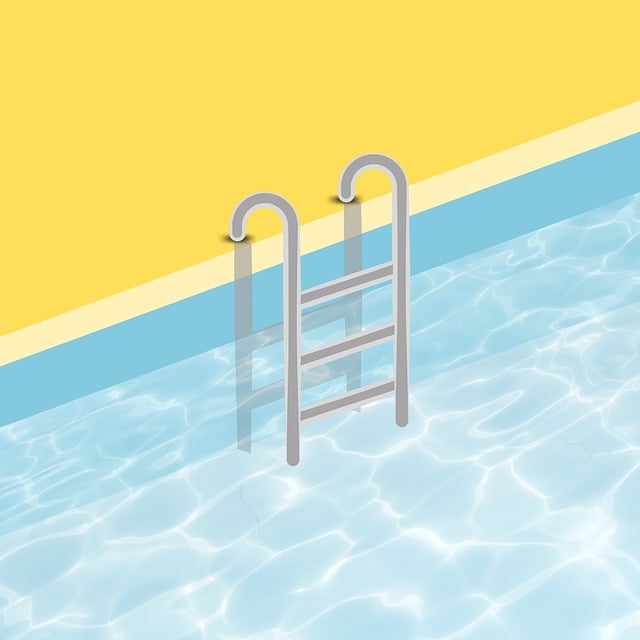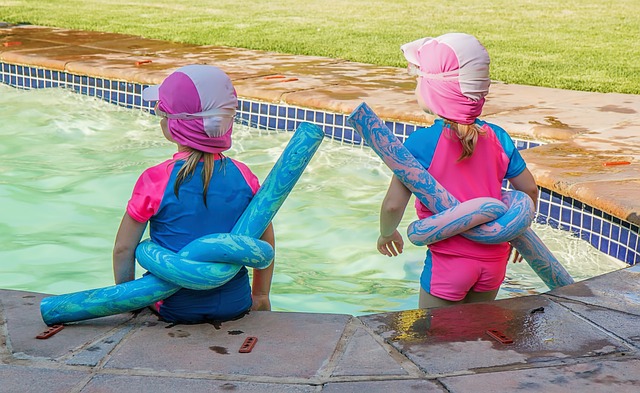When designing a safe and aesthetically pleasing pool deck, it's crucial to consider space utilization, safety regulations, material durability, and maintenance ease. Optimal pool decks integrate materials like concrete or composite decking that offer longevity, slip resistance, and resistance to environmental factors. Enhancements such as non-slip surfaces, strategic lighting, and landscaping not only bolster safety but also significantly improve the area's visual appeal. Composite decking is a favorite due to its low maintenance and protection against decay and pests, while concrete provides versatility with design options like stamping, dyeing, or texturing to mimic natural materials. The incorporation of radiant heating in concrete decks can extend swimming seasons by keeping the surface warm. A well-designed pool deck should balance safety with visual charm, utilizing textured surfaces for non-slip benefits and strategic lighting for both functionality and ambiance. LED lights offer both safety and sophistication, providing options from subtle to vibrant to suit different preferences or occasions. The use of cool tones near water features or warmer colors for a cozy vibe can enhance the pool area's atmosphere. Ultimately, a thoughtfully designed pool deck that considers material harmony with the surrounding landscape and natural light conditions will result in a functional, safe, and visually captivating outdoor space for years to come. Keywords: pool deck, pool surround design.
When envisioning a backyard oasis or an elegant resort-style retreat, the design of a pool deck transcends mere functionality—it’s about crafting a harmonious blend of safety and style. This article guides you through the essentials of expertly designing a pool surround that not only protects but also dazzles. From assessing your space and prioritizing safety to selecting durable materials for your pool deck and integrating ergonomics with aesthetics, discover how to achieve the perfect balance in your outdoor design. Additionally, explore how strategic lighting, texture, and color choices can elevate your pool surround’s visual appeal, creating an inviting and visually stunning environment for years to come.
- Assessing Space and Safety: The First Steps in Designing a Functional Pool Surround
- Material Options for a Durable and Attractive Pool Deck
- Integrating Aesthetics with Ergonomics: Pool Surround Design Tips for the Perfect Balance
- Lighting, Texture, and Color: Enhancing Your Pool Surround's Visual Appeal
Assessing Space and Safety: The First Steps in Designing a Functional Pool Surround

When embarking on the design of a pool surround, the initial phase involves a meticulous assessment of space and safety. Homeowners must consider the dimensions of their yard and the proximity of the pool to structures or boundaries to ensure compliance with local regulations and standards for pool safety. The layout of the pool deck should prioritize a clear walkway around the perimeter, allowing for easy access and unobstructed movement, which is not only conducive to safety but also enhances the overall functionality of the area.
Selecting appropriate materials for the pool deck is crucial; options like concrete, travertine, or composite decking offer a balance between durability, low maintenance, and aesthetic appeal. These materials are chosen not only for their visual impact but also for their slip-resistance and ability to withstand environmental factors such as sunlight, moisture, and temperature extremes, thereby ensuring both safety and longevity of the pool surround. Additionally, incorporating design elements like non-slip textures, lighting, and strategic plant life can further elevate the pool area’s safety and visual appeal without compromising functionality.
Material Options for a Durable and Attractive Pool Deck

When crafting a pool deck that balances durability with allure, homeowners and designers often explore a variety of material options. Composite decking stands out as a favored choice for its low maintenance requirements and resistance to rot and insect damage, ensuring a safe and long-lasting surround for the pool. The material’s versatility in color and finish allows it to complement any outdoor aesthetic, from the tranquil charm of a wooden deck to the modern sophistication of a sleek, contemporary space.
Concrete is another robust option that offers unparalleled design flexibility with its ability to be stamped, dyed, or imprinted with textures that mimic natural stone or wood grains. Its longevity and strength make it an ideal candidate for pool decks, capable of withstanding the elements while providing a customizable and functional space that can enhance both the safety and visual appeal of your backyard oasis. Additionally, the integration of radiant heating within concrete can extend the swimming season by warming the deck surface, adding to the overall comfort and enjoyment of the pool area.
Integrating Aesthetics with Ergonomics: Pool Surround Design Tips for the Perfect Balance

When designing a pool surround that harmonizes both aesthetics and ergonomics, the choice of materials for the pool deck plays a pivotal role. Opting for non-slip surfaces such as textured concrete or natural stone not only ensures safety but also contributes to the overall design. The textures and patterns inherent in these materials can be both visually appealing and practical, providing traction underfoot while complementing the pool’s architectural style. Strategic lighting is another element that enhances both functionality and beauty; LED lights embedded within the deck or pathway illuminate the area safely at night, creating a serene ambiance that invites relaxation as much as use.
Incorporating greenery into the pool surround design can further enhance the space’s aesthetics without compromising safety. Low-maintenance plants and shrubs, selected for their tolerance to moisture and direct sunlight, soften the transition from hardscape to water feature and add a layer of natural beauty. The use of modular pavers or tiles allows for easy access for maintenance and also offers design flexibility; these can be arranged in patterns that are both functional and visually striking, ensuring that the pool surround is as safe as it is captivating. To achieve the perfect balance between form and function, it’s advisable to work with a professional designer who specializes in pool deck layouts, combining their expertise with your personal preferences for a space that’s both beautiful and safe.
Lighting, Texture, and Color: Enhancing Your Pool Surround's Visual Appeal

When designing a pool deck that not only provides a safe environment but also exudes visual allure, the strategic use of lighting, texture, and color plays a pivotal role. LED lighting fixtures can transform the ambiance of your pool surround, offering both functional and aesthetic benefits. These lights not only extend the usability of your outdoor space into the evening hours but also add an element of sophistication with options ranging from subtle moonlight effects to vibrant, dynamic displays that can be adjusted to match any mood or occasion. The choice of lighting fixtures should complement the pool deck’s design and enhance its safety by ensuring ample illumination for nighttime use.
Incorporating diverse textures into your pool surround can elevate its visual appeal while also contributing to a safer environment. Textured surfaces, such as natural stone or concrete with embossed patterns, provide a non-slip surface that reduces the risk of accidents. These materials also add depth and interest to the space, creating a tactile experience that invites exploration and engagement. When selecting textures, consider how they will feel underfoot when wet, ensuring comfort and safety for all users.
Color choices in your pool deck design can significantly impact the overall aesthetic of the space. Cool tones like blues and greens evoke a serene atmosphere that complements the water feature, while warmer colors such as beiges or tans can create a cozy, inviting vibe. The use of color should consider the surrounding landscape and the natural light conditions to ensure harmony and visual continuity. Additionally, lighter colors tend to reflect more sunlight, helping to keep the area cooler during the hottest days of summer.
By thoughtfully integrating lighting, texture, and color into your pool deck design, you can create a space that is both functional and visually stunning, enhancing the enjoyment of your pool surround for years to come.
When designing a pool deck, the focus should be on creating a space that is as safe as it is visually appealing. This article has explored the critical aspects of designing a functional and attractive pool surround, emphasizing the importance of assessing available space and safety as the first steps. By considering material options for a durable pool deck, homeowners can ensure longevity and ease of maintenance. The integration of aesthetics with ergonomics provides a harmonious balance that enhances both the functionality and beauty of the environment. Furthermore, thoughtful choices in lighting, texture, and color can significantly elevate the visual appeal of your pool surround, making it a focal point of your outdoor living space. In conclusion, a well-designed pool deck not only complements the pool but also offers a safe and inviting area for relaxation and enjoyment, all year round.
